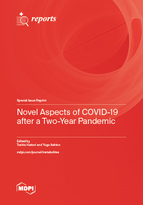Novel Aspects of COVID-19 after a Two-Year Pandemic
A special issue of Reports (ISSN 2571-841X).
Deadline for manuscript submissions: closed (15 July 2022) | Viewed by 40549
Special Issue Editors
2. Emeritus Professor, Tohoku University, Sendai 980-8577, Miyagi, Japan
Interests: dengue; malaria; leptospirosis; HIV; tuberculosis; inflammation; galectins; osteopontin
Special Issues, Collections and Topics in MDPI journals
Interests: HIV; infection
Special Issues, Collections and Topics in MDPI journals
Special Issue Information
Dear Colleagues,
In these two years more than 500 million peoples have been infected with SARS-CoV2 and among them more than 5 million people have died. The latest technology has been introduced and major advantages have been made in diagnosis, treatment and prevention. In this Special Issue, we will publish novel aspects of COVID-19 after a two-year pandemic as follows.
- Development of diagnosis methods.
- Therapeutic effects of new agents.
- Improvements of monitoring and managements of patients.
- Characteristics of break-through infection.
- Sequelae of COVID-19 infections.
- Development of vaccine against COVID-19 infection.
- Disasters caused by COVID-19 infection.
Prof. Dr. Toshio Hattori
Dr. Yugo Ashino
Guest Editors
Manuscript Submission Information
Manuscripts should be submitted online at www.mdpi.com by registering and logging in to this website. Once you are registered, click here to go to the submission form. Manuscripts can be submitted until the deadline. All submissions that pass pre-check are peer-reviewed. Accepted papers will be published continuously in the journal (as soon as accepted) and will be listed together on the special issue website. Research articles, review articles as well as short communications are invited. For planned papers, a title and short abstract (about 100 words) can be sent to the Editorial Office for announcement on this website.
Submitted manuscripts should not have been published previously, nor be under consideration for publication elsewhere (except conference proceedings papers). All manuscripts are thoroughly refereed through a single-blind peer-review process. A guide for authors and other relevant information for submission of manuscripts is available on the Instructions for Authors page. Reports is an international peer-reviewed open access quarterly journal published by MDPI.
Please visit the Instructions for Authors page before submitting a manuscript. The Article Processing Charge (APC) for publication in this open access journal is 1400 CHF (Swiss Francs). Submitted papers should be well formatted and use good English. Authors may use MDPI's English editing service prior to publication or during author revisions.
Keywords
- COVID-19
- SARS-CoV2
- diagnosis
- treatment
- prevention
- infection
- monitoring
- vaccine
- sequelae
- characteristics






